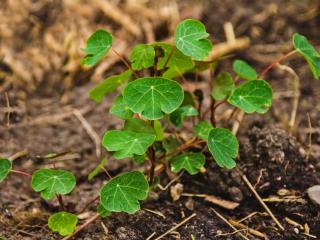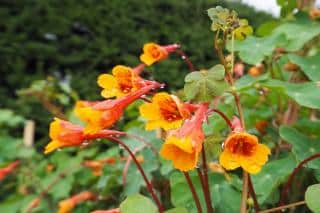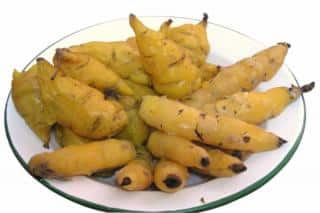

Mashua is a nasturtium root crop selected by ancient Incas.
Key mashua facts
Name: Tropaeolum tuberosum
Common: mashua, tuber nasturtium
Family: Tropaeolaceae, tuber veggie
Height: 6 to 10 feet (2 to 3 m)
Exposure: sun, part shade eventually
Planting distance: 20 inches (50 cm)
Soil: light, humiferous, well-draining – Planting: spring’s end – Harvest: fall
Certainly you’ve heard of climbing nasturtium that flows through flower beds in the garden, which you might have planted to lure aphids away from the vegetable patch. How about meeting its cousin, the tuber nasturtium?
This climbing perennial hails from South America, where it has been grown for generations for its one-of-a-kind tasty tubers. It is very resilient and contains many nutrients.
Note that roots aren’t everything: the rest of the plant, from leaf to flower, will definitely elicit glee from anyone tasting your new nasturtium-filled recipes!
Mashua is a root crop, so well-draining and loose soil is always a plus.
In Fall, prepare your soil with a generous amount of soil amendments such as soil mix, sand for drainage and ashes for potassium nutrients.
Indeed, it’s important to note that tuber nasturtium grows best in light, well-draining soil types.
In Spring, just before planting, shuffle the soil around in the planting area, adding more compost or fully ripe manure.

Near each stake, transplant one of the young seedlings. For a better harvest, make sure your seedlings start off in full sun. Since mashua is a very productive plant, just a few specimens will do for the needs of a whole family.

Mashua is more vulnerable to pests and parasites than it is to disease. Among the most common bugs that prey on the plant, you’ll find caterpillars and flea beetles (Epithrix spp.) which tend to devour stems and leaflets on sprouts and adult plants. Like all species of nasturtium, it is highly vulnerable to aphid attacks, especially the black aphid species).
Harvest takes place in Autumn, when leaves have already died off. Unearth the tubers with a spading fork. This reduces the risk of damaging them.
A good thing to know is that it’s perfectly possible to simply keep the tubers in place in the ground, and only harvest them when you’re about to consume them. There is a chance, however, that rodents take a nibble at them in this case.
→ To avoid this problem: store your harvest in a dry sand silo or crate and keep it in the dark, away from light.

Roots can come in different colors, mainly because of minor genetic differences, but their nutritional value and taste are the same.
When uprooting the plant for its tubers, make sure not to drive the pitchfork too close to the stem, since most of the roots are clustered right around the base.